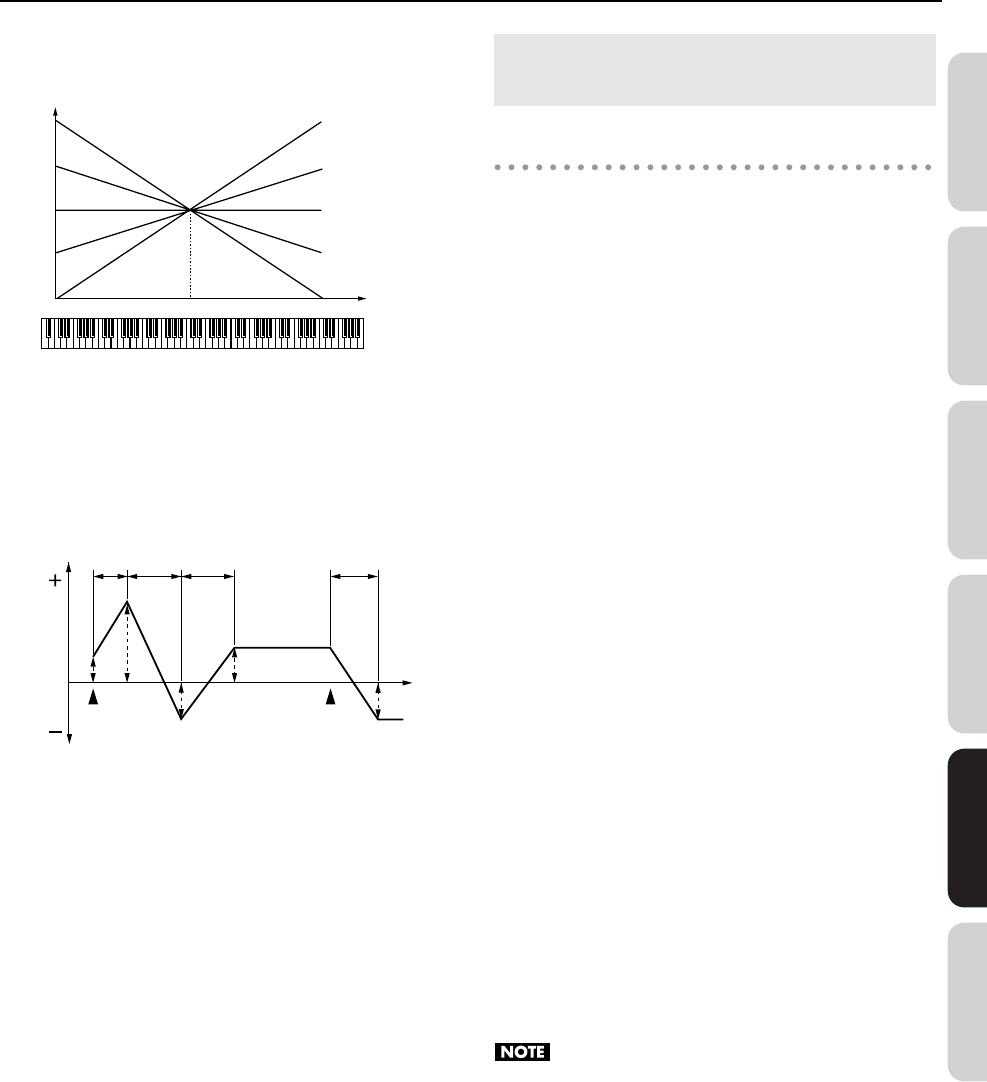
109
Creating a Patch
Overview Connections VS-700C Console VS-700R I/O Fantom VS Appendix
Value:
-100, -90, -80, -70, -60, -50, -40, -30, -20, -10, 0,
+10, +20, +30, +40, +50, +60, +70, +80, +90, +100
fig.06-031.e
P-Env Time 1–4 (Pitch Envelope Time 1–4)
★
Specify the pitch envelope times (Time 1–Time 4). Higher
settings will result in a longer time until the next pitch is
reached. (For example, Time 2 is the time over which the
pitch changes from Level 1 to Level 2.)
Value:
0–127
fig.06-032.e
P-Env Level 0–4 (Pitch Envelope Level 0–4)
Specify the pitch envelope levels (Level 0–Level 4). It
determines how much the pitch changes from the reference
pitch (the value set with Coarse Tune or Fine Tune on the
Pitch screen) at each point. Positive (+) settings will cause the
pitch to be higher than the standard pitch, and negative (-)
settings will cause it to be lower.
Value:
-63– +63
Patch TVF
Filter Type
Selects the type of filter. A filter cuts or boosts a specific
frequency region to change a sound’s brightness, thickness,
or other qualities.
Value
OFF:
No filter is used.
LPF:
Low Pass Filter. This reduces the volume of all
frequencies above the cutoff frequency (Cutoff
Freq) in order to round off, or un-brighten the
sound. This is the most common filter used in
synthesizers.
BPF:
Band Pass Filter. This leaves only the frequencies
in the region of the cutoff frequency (Cutoff
Freq), and cuts the rest. This can be useful when
creating distinctive sounds.
HPF:
High Pass Filter. This cuts the frequencies in the
region below the cutoff frequency (Cutoff Freq).
This is suitable for creating percussive sounds
emphasizing their higher tones.
PKG:
Peaking Filter. This emphasizes the frequencies in
the region of the cutoff frequency (Cutoff Freq).
You can use this to create wah-wah effects by
employing an LFO to change the cutoff
frequency cyclically.
LPF2:
Low Pass Filter 2. Although frequency
components above the Cutoff frequency (Cutoff
Freq) are cut, the sensitivity of this filter is half
that of the LPF. This makes it a comparatively
warmer low pass filter. This filter is good for use
with simulated instrument sounds such as the
acoustic piano.
LPF3:
Low Pass Filter 3. Although frequency
components above the Cutoff frequency (Cutoff
Freq) are cut, the sensitivity of this filter changes
according to the Cutoff frequency. While this
filter is also good for use with simulated acoustic
instrument sounds, the nuance it exhibits differs
from that of the LPF2, even with the same TVF
Envelope settings.
If you set “LPF2” or “LPF3,” the setting for the Resonance
parameter will be ignored (p. 110).
C4C3C2C1 C5 C6 C7
0
+50
+100
-50
-100
Key
Time
T1 T2 T3 T4
L3
L4
L2
L1
L0
Note off
Pitch
Time
Note on
T: Time L: Level
Modifying the Brightness of a Sound
with a Filter (TVF/TVF Env)
VS-700_r_e.book 109 ページ 2008年11月20日 木曜日 午後2時28分


















